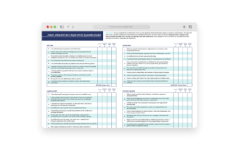Social phobia. Perfectionism. Relationship insecurity. Panic attacks. Procrastination. Health anxiety. Career indecision. Existential dread.
As clinicians, we likely encounter these seemingly disparate manifestations of anxiety daily in our practice. At first glance, they appear to be distinct issues requiring different treatment approaches. Yet beneath these varied presentations often lies a handful of fundamental fears.
A compelling framework developed by anxiety specialist Dr. Todd Pressman suggests that many anxiety patterns can be traced back to five core fears—universal human concerns that manifest in predictable defensive responses. Recognizing these patterns offers clinicians a powerful lens for conceptualizing cases and guiding therapeutic interventions that go beyond simple symptom management.
Share this Article:
Top Picks for You:
- The Four Attachment Styles: Secure, Avoidant, Ambivalent, and Disorganized
- Toxic Shame: What Is It & What to Do About It
- The Power of Trauma-Informed Care: Understanding What Happened to You
- Somatic Resilience: Overcoming Early Trauma (with Peter A. Levine, PhD)
- Neuroplasticity: Rewiring the Traumatized Brain
Beyond Symptom Management
The Five Core Fears in Clinical Practice
While many treatment modalities can effectively address anxiety’s immediate manifestations—the racing thoughts, somatic arousal, and avoidance behaviors—lasting transformation requires exploring the deeper terrain. As therapists, we’ve all seen how symptom-focused interventions may provide relief yet fail to prevent recurrence if the core issues remain unaddressed.
Dr. Pressman’s Deconstructing Anxiety framework offers a roadmap for identifying the fundamental concerns that drive anxious patterns, helping clients move beyond coping and toward genuine healing. By identifying a client’s dominant core fear, we gain insight not only into their defensive strategies but also into targeted paths for therapeutic change

1. Loss of Love
Fear of abandonment, rejection, or disconnection
At its heart, this fear reflects a longing for belonging—and the terror that connection could be withdrawn at any moment. When this fear is dominant, clients may organize their lives around not being left.
What It Looks Like in Practice:
- People-pleasing and difficulty asserting needs
- Constant scanning for signs of disapproval
- Codependency or anxious attachment
- Emotional suppression to preserve relationships
- Avoidance of intimacy out of fear it won’t last
- “Reject before being rejected” defensive strategies
Relational and Attachment Roots:
This fear often emerges from early caregiving marked by unpredictability—where connection felt conditional or inconsistent. The nervous system, primed to expect rupture, learns to shape-shift to preserve attachment at all costs. In therapy, clients may unconsciously recreate these dynamics with the therapist, becoming hyper-attuned to perceived shifts in attunement.
2. Loss of Identity
Fear of engulfment, loss of self, or being controlled
This fear surfaces when one’s sense of self feels fragile, threatened, or difficult to define. Clients may be consumed with maintaining coherence or independence, often at the expense of connection or growth.
What It Looks Like in Practice:
- Rigid identity roles or perfectionistic self-presentation
- Over-identification with achievement or image
- Resistance to vulnerability, ambiguity, or change
- Aversion to developmental shifts (e.g., parenting, aging)
- Emotional compartmentalization to maintain control
Developmental Origins:
Often linked to controlling or dismissive caregiving, this fear reflects an environment where autonomy was undermined or authentic expression was not safe. These clients may present as highly self-reliant in therapy, preferring structure over emotional exploration.

3. Loss of Meaning
Fear that life is empty, purposeless, or incoherent
This fear often emerges during periods of loss or transition. Clients may be plagued by a sense that their suffering has no point, or that life is devoid of coherence.
Presenting Patterns:
- Chronic seeking without fulfillment
- Cynicism or detachment as armor
- Over-intellectualization and emotional disengagement
- Avoidance of stillness or introspection
- Numbing or escapism to fend off feelings of futility
Therapeutic Opportunities:
These clients often benefit from narrative and meaning-making work. Helping them reclaim values, connect with purpose, and develop new frameworks of meaning can offer a renewed sense of vitality and direction.
4. Loss of Purpose
Fear of aimlessness, stagnation, or unrealized potential
This fear is about direction—not just surviving, but contributing, achieving, becoming. It often drives clients who are successful on paper but disconnected internally.
Common Presentations:
- Chronic indecision or inability to commit to life paths
- Compulsive productivity and over-scheduling
- Restlessness or persistent dissatisfaction
- Deferred dreams and neglected aspirations
- Avoidance of long-term planning or future thinking
Clinical Focus:
Clients often experience grief for the road not taken. Therapy may involve helping them rediscover values, take aligned action, and build a more integrated sense of fulfillment. Somatic practices and visioning tools can support them in grounding purpose beyond external benchmarks.
5. Fear of Death
Fear of mortality, impermanence, or annihilation
The most existential of the core fears, this concern about the finitude of life often operates quietly beneath the surface, only emerging through metaphor, health fears, or control issues.
Ways It May Present:
- Health anxiety or somatic hypervigilance
- Intolerance of uncertainty or change
- Panic attacks after loss or trauma
- Avoidance of aging, mortality, or future planning
- Legacy obsession or fixation on youth
Therapeutic Process:
Rather than focusing on symptom elimination, therapy here may emphasize existential acceptance, mindfulness, and developing meaning frameworks that allow the client to live more fully in the face of impermanence.

Applying the Five Core Fears in Clinical Work
Understanding a client’s dominant core fear provides a powerful lens for case formulation. But to truly support transformation, we must also identify the protective strategies they’ve developed to avoid feeling that fear—what Dr. Pressman refers to as the chief defense.
These defenses often appear as symptoms themselves: perfectionism, people-pleasing, over-intellectualizing, avoidance, or control. While highly adaptive at first, these strategies tend to backfire over time, reinforcing the very fear they were meant to avoid
Examples of common chief defenses include:
- Perfectionism
- Hopelessness
- Agitation
- People-pleasing
- Judgmentalness
- Emotional suppression
- Overwork or compulsive busyness
Rather than pairing defenses with specific fears, the goal is to uncover a client’s unique combination. This personalized understanding allows us to help clients gently loosen their grip on these strategies and begin to face the underlying fear with support.
Clinical Guidelines for Integration
Assessment Considerations:
- Listen for which “loss” evokes the strongest emotional charge
- Explore early attachment patterns and relational injuries
- Identify defensive strategies that block emotional vulnerability
- Notice patterns across life domains, not just presenting symptoms
Treatment Strategies:
- Validate the adaptive function of defenses before challenging them
- Build emotional capacity to stay present with the feared experience
- Help clients identify and gently “do the opposite” of their habitual defense
- Support meaning-making, value exploration, and visioning for future self
Deconstructing Anxiety
This is the promise of deconstructing anxiety: when we unpack both the fear and the defense, we gain insight into the organizing themes of a client’s inner world. Anxiety is no longer simply a problem to manage, but a signal—a pointer toward unmet existential needs and unprocessed emotional truths.
When we support clients in recognizing and releasing their defenses, we help them access greater authenticity, resilience, and vitality. What once looked like pathology becomes a meaningful and workable terrain—one that already holds the blueprint for healing.





Ready to Begin Your Healing Journey?
Browse on-demand courses and begin learning from top experts today!


